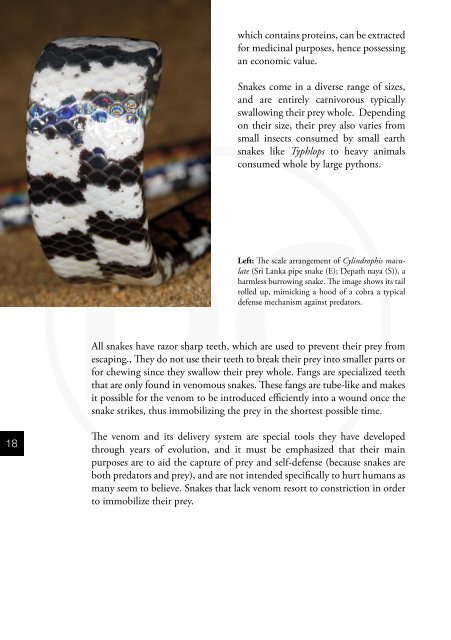Recognizing Deadly Venomous Snakes from Harmless Snakes of Sri Lanka
Recognizing Deadly Venomous Snakes from Harmless Snakes of Sri Lanka
Recognizing Deadly Venomous Snakes from Harmless Snakes of Sri Lanka
Create successful ePaper yourself
Turn your PDF publications into a flip-book with our unique Google optimized e-Paper software.
which contains proteins, can be extracted<br />
for medicinal purposes, hence possessing<br />
an economic value.<br />
<strong>Snakes</strong> come in a diverse range <strong>of</strong> sizes,<br />
and are entirely carnivorous typically<br />
swallowing their prey whole. Depending<br />
on their size, their prey also varies <strong>from</strong><br />
small insects consumed by small earth<br />
snakes like Typhlops to heavy animals<br />
consumed whole by large pythons.<br />
Left: The scale arrangement <strong>of</strong> Cylindrophis maculate<br />
(<strong>Sri</strong> <strong>Lanka</strong> pipe snake (E); Depath naya (S)), a<br />
harmless burrowing snake. The image shows its tail<br />
rolled up, mimicking a hood <strong>of</strong> a cobra a typical<br />
defense mechanism against predators.<br />
Above: A Green pit viper, with wide open mouth<br />
showing its fangs.<br />
18<br />
All snakes have razor sharp teeth, which are used to prevent their prey <strong>from</strong><br />
escaping., They do not use their teeth to break their prey into smaller parts or<br />
for chewing since they swallow their prey whole. Fangs are specialized teeth<br />
that are only found in venomous snakes. These fangs are tube-like and makes<br />
it possible for the venom to be introduced efficiently into a wound once the<br />
snake strikes, thus immobilizing the prey in the shortest possible time.<br />
The venom and its delivery system are special tools they have developed<br />
through years <strong>of</strong> evolution, and it must be emphasized that their main<br />
purposes are to aid the capture <strong>of</strong> prey and self-defense (because snakes are<br />
both predators and prey), and are not intended specifically to hurt humans as<br />
many seem to believe. <strong>Snakes</strong> that lack venom resort to constriction in order<br />
to immobilize their prey.<br />
Left: Coeloganthus helena (Trinket snake (E);<br />
Katakaluwa (S)), a slightly venomous snake, with<br />
its mouth wide open showing its teeth. The orange<br />
arrow shows its fangs positioned towards the rear<br />
<strong>of</strong> its mouth, such fangs are known as back fangs.<br />
As mentioned before, not all snakes<br />
are venomous. The composition <strong>of</strong> the<br />
venom and its quantities vary <strong>from</strong><br />
species to species. In general it is a<br />
complex mixture <strong>of</strong> proteins which can<br />
be categorized according to the organs<br />
they attack i.e. neurotoxic (attacks<br />
the nervous system) or haemototoxic<br />
(attacks the circulatory system).<br />
Depending on their ability to kill their<br />
prey and the composition <strong>of</strong> venom they<br />
possess, snakes have been grouped in to<br />
four categories i.e. deadly venomous,<br />
moderately venomous, mildly venomous<br />
and non-venomous.















